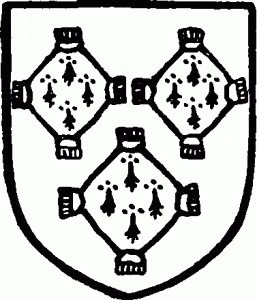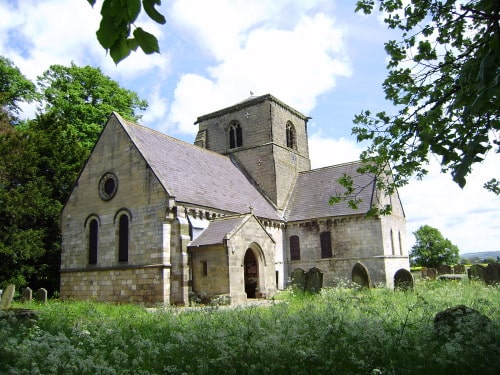Buttercrambe Castle at Bossall
Buttercrambe Castle at Bossall stood in what is now Aldby Park. It appears that there were fortifications at the site for many years with earthworths being noted that may have prehistoric origins. The Normans are known to have constructed a Motte and Bailey Castle on the site, and a licence to crenellate was issued to William d’Estoteville in 1201. The castle was upgraded in the 14th century, before being replaced by a house and gardens in the 17th century.
Buttercrambe Castle
Buttercrambe Castle at Bossall was located in Ryedale, North Yorkshire. This is an important location that was had significance to the defence of the Marches. The site was developed in phases.
Early fortifications
The first phase was earthworks which have not been comprehensively dated. These are some 100 metres in length, 10 metres wide, 3 metres high with a flat top. Ditches were adjacent to this earthwork.
Norman Motte and Bailey
The Normans are thought to have built a Motte and Bailey Castle at Buttercrambe. A licence to crenellate was issued to William d’Estoteville in 1201. This would have been the first stone castle on the site and is the first for which formal records are available.
Gatehouse Gazetteer notes of this construction that:
The ‘well-built’ capital messuage of 1282 may have been the building inclosed and fortified by William de Stutevill.
Victoria County History via Gatehouse Gazetteer
14th Century Keep at Buttercrambe Castle at Bossal
A quadrangular tower was built at Buttercrambe in the 14th century. This tower was rare in that it incorporated a double curtain wall and round towers. Typically quadrangular keeps of the period had squared towers, sometimes constructed at an angle, as at Danby Castle. Other castles, particularly those in North Yorkshire that were built in the same period, such as Bolton Castle in Wensleydale, or the refinements at Raby Castle, also had squared towers and no double curtain wall: though at Raby there were additional features which more than catered for this defensively.
Though the castle was demolished in the 17th century it is possible to identify the imprint of the castle, as its foundations, earthworks, and moat are all visible [in part] to the naked eye.
The great hall of Buttercrambe Castle was impressive. It measures 105 metres from north to south and 70 metres from east to west. Today a dry ditch shows where the castles moat was. It remains an obstacle and suggests that at its peak the moat was 10 metres wide by 2.5 metres deep. This would have acted as a deterrent to mining operations and prevented use of some siege weapons.
Three sides of the castle had an outer court, or bailey. This extended from the moat outwards, providing an area stretching between 20 and 35 metres from the side of the moat. This Bailey or Outer Courtyard was also surrounded by an outer moat, which was 8 metres wide and 2 metres deep. The Bailey also had a curtain wall. Some of the footings of this wall remain but it is not yet been established how thick these walls were, or how high they would have stood.
In effect the Tower has replicated the layout of the former Motte and Bailey Castle, simply relacing the Motte and its earlier construction with a stronger quadragular tower.
Landholders of Bossal and Buttercrambe Castle
The Manor of Bossall was held by the de Bossall family from at least 1202 until 1423 when it passed into the hands of the Redmayne family [who also held a share of Harewood Castle].
- Paulinus de Bossall and his wife Julia held Bossall in 1202.
- Richard de Bossall was a patron of the church constructed c1230
- William de Bossall inherited from Richard. He was a minor in the custody of Devorgill de Stutevil in 1238 and died sometime between 1277 and 1280.
- Sir John de Bossall known to have held Bossall in 1280.
- William de Bossall is known to have contributed to the subsidy in 1301 but is confirmed as Lord of the Manor in documents dating to 1316.
- Thomas de Bossall. Dates uncertain but he had died before 1349.
- William de Bossall known to have held Bossall in 1349. Had died in or before 1353.
- Robert de Bossall held the Manor from 1353. Date of death unclear as the next record for the ownership of the Manor is 1416.
- William de Bossall held the manor in 1416, possibly earlier. He died in 1423.
- In 1423 the Manor passed to the Redmayne family.

Buttercrambe Castle at Bossall Links
Historic England – official listing for Buttercrambe Castle at Bossall.
Jamieson, E. and Pearson, T. (2021). An Archaeological Survey of an Earthwork at Aldby Park, Buttercrambe, North Yorkshire. York: Scarborough Archaeological & Historical Society. https://doi.org/10.5284/1113099
British History Online – Parishes: Bossall’, in A History of the County of York North Riding: Volume 2, (London, 1923) pp. 91-98. British History Online.
Gatehouse Gazette – Buttercrambe Castle, list of sources.
Heritage Gateway – Sources on Buttercrambe Castle.
Featured Image
St Botolph, Bossall. Patronage was given to the church by the de Bossall family.
